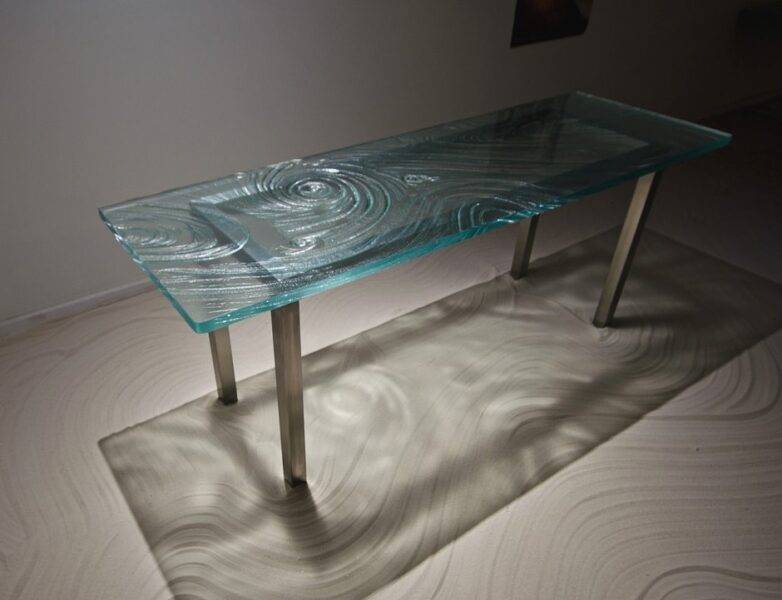Last updated on April 19th, 2022 at 09:50 am
Glass Countertops: Thermoformed, Fused, Tempered, Annealed.
Here at Downing Designs, we often receive questions about our glass countertops about whether they are Tempered, Annealed, Fused or Thermoformed. Here, we hope to quickly delineate these processes for you as they primarily relate to our custom textured glass countertops.
Thermoforming is the process we use where glass (sheets or pieces) are placed atop a mold or sand bed inside a kiln which is gradually heated to its melting point to allow it to take the form of the mold. The amount of detail possible in thermoforming is amazing and this technique allows glass to be crafted into many beautiful shapes and sizes, including our glass countertops. Textures are designed by hand in a bed of technical sand in our large kilns to impart the exact look that our client desires. These textured glass shapes can be organic, linear, or any combination.
Thermoforming involves fusing several layers of glass sheets above 1400 F and then cooling and annealing them after it is thermoformed to impart additional strength to the now thick unit of glass (typically 1.5” thick). This Annealing takes time. On large, thick pieces it can take from 5-10 days. The upside is the glass piece emerges as one, and is able to be cut and polished afterwards.
Our textured glass is fused, thermoformed, and annealed. It is very interesting to see several layers of glass act as one thick piece as evidenced when we take remnants…they fracture as one clean, solid piece.
Annealing is a process where glass is cooled slowly after it has been thermoformed. Its goal is to relieve the internal stresses inside the now fused thick glass. Glass must be cooled so that its center, and its edges are typically within 5 F of one another as it cools from 1400 F…hence the time-consuming nature of annealing, especially with larger and/or thick slabs. Thick, annealed glass is very strong, typically breaking above ~6000 lbs per sq inch which is more than adequate for countertop usage.
Tempering glass is a process which imparts strength to glass products that enable it to be utilized in situations where it would be too dangerous without tempering e.g thin shower doors, and side windows in cars. When broken, tempered glass breaks smaller, relatively safe pieces. You must first cut and polish the glass since tempered glass cannot be cut.
The process is as follows:
- Cut and polish glass to size.
- Heat glass to about 1140 F and then rapidly “quench” or cool the glass. Cooling the outer surfaces of the glass much more quickly than the center causes the center to contract from the outer surfaces. The center remains in tension, as the outer surfaces compress. This effect is what imparts strength to tempered glass.
While this makes tempered glass 2-4x stronger than annealed glass. Also, because of the high surface tension created in the glass tempering process, you CANNOT temper deeply textured glass without a high risk of it shattering during the tempering process.
All of this to say that our typically 1.5” thick glass countertops are thermoformed, fused, and highly annealed, but not tempered. They do not need to be. Our glass is plenty strong enough as evidenced by the numerous cantilevered glass countertop installation we have successfully performed. They are crafted by a highly technical process that imparts beautiful textures that will last for a lifetime with proper care.
Many scratches in glass countertops can be removed with a glass polishing kit in the hands of a professional. Deep scratches may not be able to be removed and thus are to be avoided.
Jeff Downing

